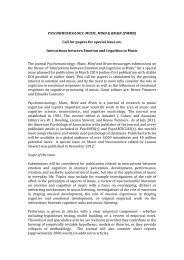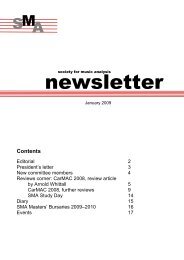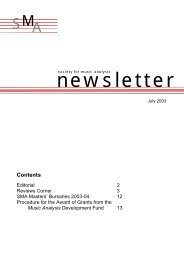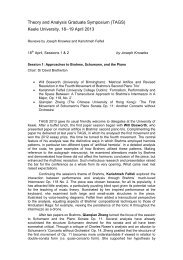Here - Society for Music Analysis
Here - Society for Music Analysis
Here - Society for Music Analysis
Create successful ePaper yourself
Turn your PDF publications into a flip-book with our unique Google optimized e-Paper software.
‘A more tuneable Speaking’: Secco Recitative inEnglish, 1700-1710The first decade of the eighteenth century was a period of great change <strong>for</strong> English recitative. In thespace of six years, John Eccles, the Master of <strong>Music</strong>k, moved away from Purcellian arioso in hissetting of William Congreve’s masque The Judgement of Paris (1701) and produced a unique andsuccessful secco recitative in Congreve’s Semele (completed 1707), one of the most significantattempts at all-sung English opera after the Italian manner. This paper will examine how, in light ofthe success of Thomas Clayton’s Arsinoe (1705), the collaborative approach of Congreve and Ecclesto the construction of the libretto and setting of recitative was consciously influenced by theemerging Italianate style. Clayton and Eccles’s interpretation and adaptation of existing Italianmodels of secco recitative by composers including Giovanni Bononcini, Jakob Greber and JohannChristoph Pepusch will also be analysed and discussed. Evidence suggests that Pepusch’s Six EnglishCantatas (published by John Walsh in 1710) were per<strong>for</strong>med earlier in the decade, perhaps evenbe<strong>for</strong>e Arsinoe. These may there<strong>for</strong>e have provided the first examples of Italianate secco recitativessung in English on the London stage and would have offered Eccles a more effective and valuableprecedent than Clayton’s poor attempts.Christopher RobertsUniversity of Leeds, Provisional Ph.D. Candidatemc07csr@leeds.ac.ukA/V Requirements: CD player and computer with Microsoft PowerPoint (preferably with internetaccess)







